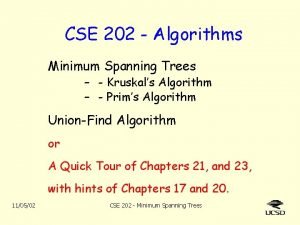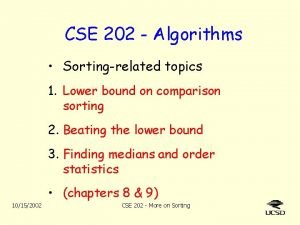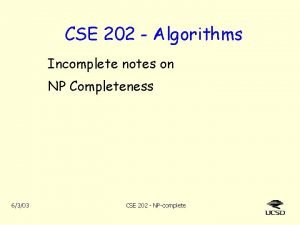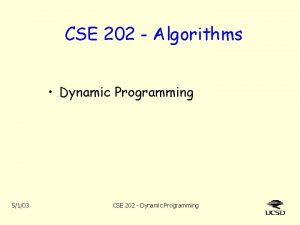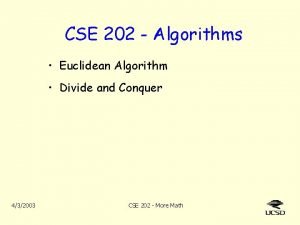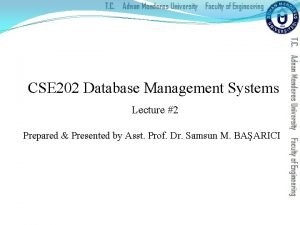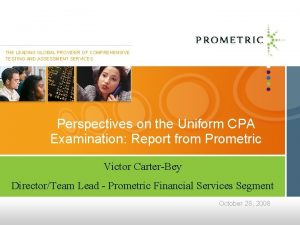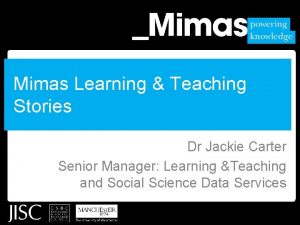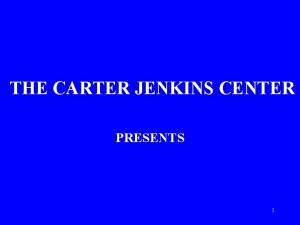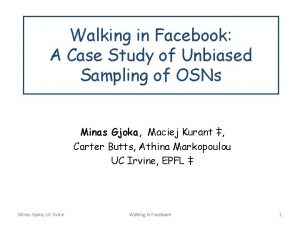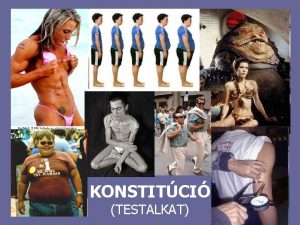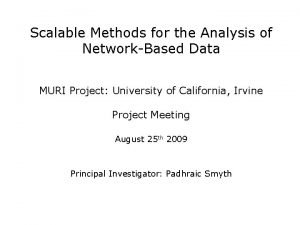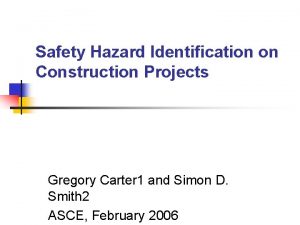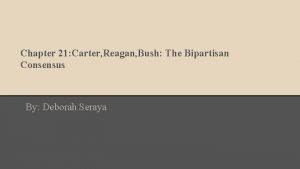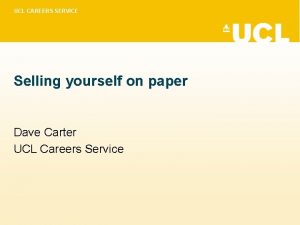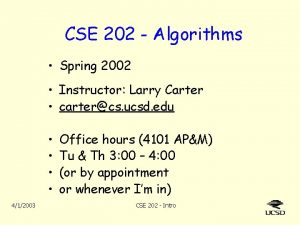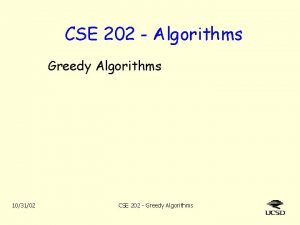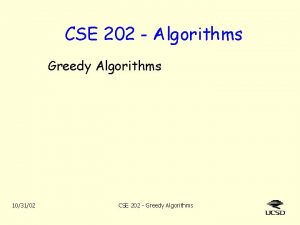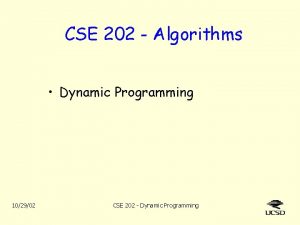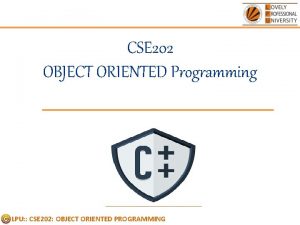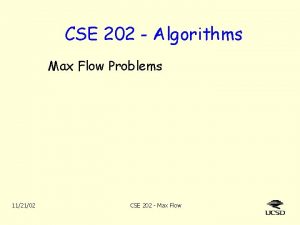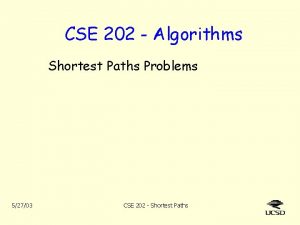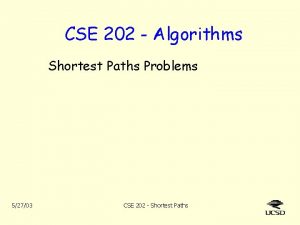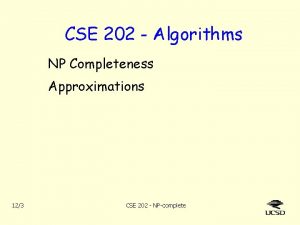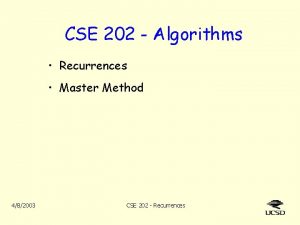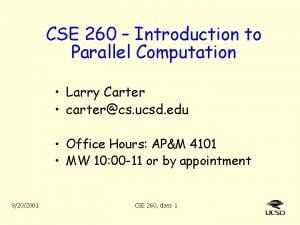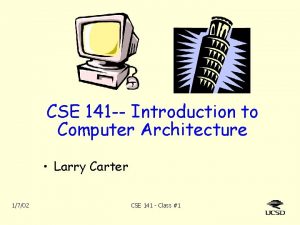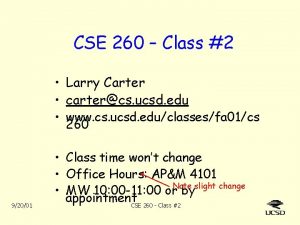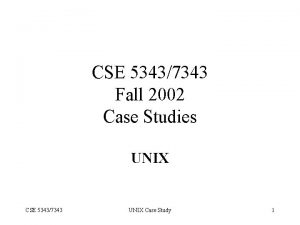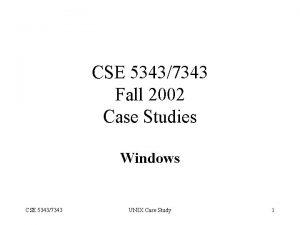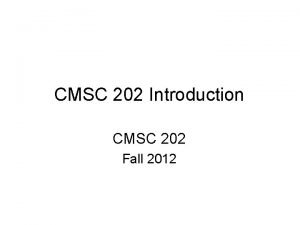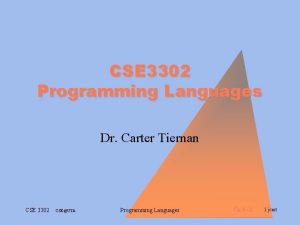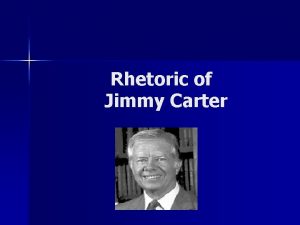CSE 202 Algorithms Fall 2002 Instructor Larry Carter
























- Slides: 24

CSE 202 - Algorithms • Fall 2002 • • • Instructor: Larry Carter carter@cs. ucsd. edu Office hours (4101 AP&M) Tu & Th 3: 30 – 5: 00 (or whenever) • TA: John-Paul Fryckman 9/26/2002 CSE 202 - Intro • jfryckm@cs. ucsd. edu

What we’ll study General Techniques Divide and Conquer, Dynamic Programming, Hashing, Greedy Algorithms, Reduction to other problems, . . . Specific Problems Sorting, shortest paths, max flow, sorting, . . . Various Paradigms Probabilistic algorithms Alternate models of computation NP Completeness 2 CSE 202 - Intro

Sounds like my undergrad course. . . • Going over same material twice is good! • We’ll probably go deeper – mathematical formalisms – modified assumptions – assorted topics every computer scientist should know. 3 CSE 202 - Intro

Logistics • Textbook: Introduction to Algorithms, 2 nd edition – Cormen, Leiserson, Rivest & Stein – First edition probably OK (new chapter K ~ old chapter (K+1). ) • Written work – Individual homeworks – Group homeworks – In-class Midterm – Final (oral? take-home? ) • Grades – A: Demonstrate mastery of material. – B (or B+ or B-): Typical grade. Understand most of material, solve most routine problems and some hard ones. – C: Really don’t “get it”. 4 – D, F: Gave up. CSE 202 - Intro

Logistics • Classes will include “lecture” (with overheads), “discussion” (at board), and “exercises” (at your seat). – I’d prefer you pay attention, think, ask questions, and participate in discussions rather than taking notes. • Website: //www. cs. ucsd. edu/classes/fa 02/cse 202 -b –. pdf and. ps of “lectures”. (Sometimes available before class. ) – Homeworks, announcements, etc. too – You are responsible for checking website • Be sure to register for the class email list – I’ll use it to send out urgent messages, like HW corrections – Directions on class webpage 5 CSE 202 - Intro

Formal Analysis of Algorithms • A problem is a (infinite) set of instances. • An instance is a triple <input, output, size> – Less formally, we treat “input” as an instance. – “Size” is related to the number of symbols needed to represent the instance, but the exact convention is problem-specific. (E. g. , nxn matrix may be “size n”. ) • A decision problem is a problem in which every instance’s output is “yes” or “no”. Example: Sorting is a problem. Note: I tend to underline terms that you should know. <5, 2, 17, 6> is an instance of sorting, with output <2, 5, 6, 17> and size 4. 6 CSE 202 - Intro

Formal Analysis of Algorithms • Algorithm: a step-by-step method of producing “output” of instances given “input” – The steps are instructions for some model of computation. – “Standard” model is the Random Access Machine (RAM) Memory ALU One needs to be careful about what operations are allowed - E. g. operations on very long numbers aren’t “one step”. - For this course – anything reasonable is OK. 7 CSE 202 - Intro

Formal Analysis of Algorithms The complexity of an algorithm is a function from (the instance size) to (the running time on instances of that size). = {0, 1, 2, . . . } (the natural numbers) But what happens if different instances of a given size have different running times? ? • Worst-case complexity: maximum of the running times over all instances of a given size. • Average complexity: average of the running times. • Probabilistic complexity: we’ll study later – can be used when a single instance has different running times. • Best-case complexity: not a very useful concept 8 CSE 202 - Intro

Mathematical notation P. T. Barnum asserted, “You can fool all of the people some of the time”. – Suppose on Monday, I fooled all the men, and on Tuesday, I fooled all the women (but not vice versa). Is this an example of Barnum’s assertion? Mathematics is (or should be) precise Let P = set of all the people, T = {Monday, Tuesday}, Let F(p, t) mean “I fooled person p at time t” Is “ p P t T F(p, t)” true? means “for all” means “there exists” Is “ t T p P F(p, t)” true? 9 CSE 202 - Intro

Classifying (complexity) functions We focus on functions from to , though definitions are general. Given function g, O(g) (pronounced “Oh of g” or “Big Oh of g”) is the set of functions (from to ) for which g is an asymptotic upper bound. This means: O(g) = {f : n 0 c>0 n>n 0 0 f(n) c g(n) } 2) Example: 3 n log n + 20 O(n Note: Since O(n 2) is a set, using “ “ is technically correct. But people often use “=“. 10 CSE 202 - Intro

Classifying (complexity) functions (g) (pronounced “Omega” or “Big Omega”) is the set of functions for which g is an asymptotic lower bound. Formally: (g) = {f : n 0 c>0 n>n 0 0 c g(n) f(n) } (g) (“Theta”) is the set of functions for which g is an asymptotic tight bound. This means: (g) = {f : n 0 c 1, c 2>0 n>n 0 0 c 1 g(n) f(n) c 2 g(n) } Theorem: (g) = (g) O(g). 11 Note: we won’t use little-o or little-omega notation. CSE 202 - Intro

Review • Consider the decision problem, “Is x prime? ” – How should we define “size”? • Consider the algorithm: if(i<2) return “no”; for i = 2 to sqrt(x) if (x%i = 0) return “no”; return “yes”; Note: when x is even, algorithm takes constant time. What is the asymptotic complexity? You should be asking, “average or worst-case”? Let’s say worst case (average complexity is harder) 12 CSE 202 - Intro

What is a proof? • Informal Proof (“Hand waving”) – Anything that convinces the reader • Formal Proof (First few classes) – A sequence of statements, each being: • a hypothesis of theorem • a definition, axiom, or known theorem • a statement that follows from previous statements via a rule of inference • Proof (Rest of course) – A subset or summary of a formal proof that convinces a literate but sleepy reader that the writer could write a formal proof if forced to. 13 CSE 202 - Intro

Notes about proofs • Use complete sentences. – Sentences have a subject (“you” may be understood), a verb, a period at the end. – If sentence is too long, introduce notation or definitions. • Each statement should indicate whether it’s an assumption, a definition, a known fact, . . . – Don’t just write, “x A”. Instead write: • “Let x A. ” if you’re introducing x and want it to be in A. • “Suppose x A. ” if x has already been introduced, and you’re seeing what would happen if it were in A. • “Thus, x A. ” if it follows from earlier statements. – Make sure each variable is properly introduced 14 • Like declaring variables in a program. CSE 202 - Intro

Some “proof schemas” • Literate readers – even sleepy ones – know that: – To show A B, can write “Let x A. (blah. . . ). Thus, x B. ” – To show A = B (for sets A and B), show A B and B A. – To show P implies Q, write “Assume P. (blah. . . ). Thus Q. ” – To show “ x P”, write “Let x=(whatever). (blah. . . ) Thus P. ” – To show “ x P”, write “Given any x, (blah. . . ). Thus P. ” – To show an algorithm has complexity O(f), you will probably construct a positive constant c and an integer n 0 and then show that if n>n 0 and I is an instance of size n, then the algorithm requires time at most c f(n) on I. 15 – These schemas can be mostly implicit. Thus, after writing “Let x A. (blah). Thus, x B. ” you often don’t need to write “This shows that A B. ” CSE 202 - Intro

Example formal proof Thm: Suppose f O(g) and g O(h). Then f O(h). Proof: Just the definition of O(g), but introduces c 0 and n 0. Since f O(g), n 0 c 0>0 n>n 0 0 f(n) c 0 g(n). Similarly, n 1 c 1>0 n>n 1 0 g(n) c 1 h(n). Let n 2 = max(n 0, n 1) and c 2 = c 0 c 1. Setup Noteforthat c 2 n is 2 positive proving c 2>0. . . since both c 0 and c 1 are. Suppose n>n 2. Then. Setup n>n 0 forand so n>n 0 2. . . f(n) c 0 g(n). proving But we also have n>n 1 and so g(n) c 1 h(n). Thus, 0 f(n) c 0 c 1 h(n) = c 2 h(n). Q. E. D. 16 Means, “We’ve proved what we intended to. ” CSE 202 - Intro

Your turn. . . Thm: If f O(g) then g (f). 17 CSE 202 - Intro

Mathematical Induction Suppose for i , Pi is a statement. Suppose also that we can prove P 0, and we can prove “ i , Pi implies Pi+1” Then the Principle of Mathematical Induction allows us to conclude “ i Pi”. P 0 18 P 1 P 2 P 3 P 4 . . . CSE 202 - Intro

Mathematical Induction Alternatively, suppose we can prove P 0, and we can prove “ i , (P 0 & P 1 &. . . & Pi) implies Pi+1” Again, the Principle of Mathematical Induction allows us to conclude “ i Pi”. P 6 P 4 P 2 P 0 19 P 1 P P 3 P 5 7 . . . CSE 202 - Intro

Induction Example Definitions from CLRS pg. 1088: A binary tree is a structure on a finite number of nodes that either contains no nodes or is composed of three disjoint subsets: a root node, a binary tree called the left subtree and a binary tree called the right subtree. The height of a non-empty tree is the maximum depth of its nodes. The depth of a node is the length of the path from the root to the node. Thm: If T is a non-empty binary tree of height h, then T has fewer than 2 h+1 nodes. 20 CSE 202 - Intro

Induction Example Let Ph be the statement, “If T is a binary tree of height h, then T has at most 2 h+1– 1 nodes. ” We will prove h Ph by induction. Base Case (h=0): T is non-empty, so it has a root node r. Let s be any node of T. Since the height of T is 0, the depth of s must be 0, so s = r. Thus, T has only one node (which is 20+1 -1). 21 CSE 202 - Intro

Induction Example Let Ph be the statement, “If T is a binary tree of height h, then T has at most 2 h+1– 1 nodes. ” We will prove h Ph by induction. Base Case (h=0): T is non-empty, so it has a root node r. Let s be any node of T. Since the height of T is 0, the depth of s must be 0, so s = r. Thus, T has only one node (which is 20+1 -1). Obviously, the only binary tree of height 0 is the tree of one node, so P 0 is true. 22 CSE 202 - Intro

Induction Example Induction step: Assume that Ph is true. Let T be a tree of height h+1. Then the left subtree L is a binary tree. If L is empty, it has 0 nodes. Otherwise, each node in L is has depth one less than its depth in T. Thus, L is a non-empty binary tree of depth at most h. By assumption OOOPS! I’ve only assumed Ph. But L may have smaller height. 23 CSE 202 - Intro

Induction Example Induction step: Assume that Pi is true i h. Let T be a tree of height h+1. Then the left subtree L is a binary tree. If L is empty, it has 0 nodes. Otherwise, each node in L is has depth one less than its depth in T. Thus, L is a non-empty binary tree of depth at most h. By assumption, L has at most 2 h+1– 1 nodes. Similarly, the right subtree R has at most 2 h+1– 1 nodes. Thus, T has at most 1 + 2 h+1– 1 = 2 2 h+1– 1 for the root for L for R = 2 (h+1)+1– 1 nodes. This shows that Ph+1 is true, and completes our proof. 24 CSE 202 - Intro
 Cse 202
Cse 202 Cse 202
Cse 202 Cse 202
Cse 202 Cse 202
Cse 202 Cse 202
Cse 202 Cse 202
Cse 202 Nixon ford carter reagan
Nixon ford carter reagan Victor carter-bey
Victor carter-bey Jackie carter porn
Jackie carter porn Carter jenkins center
Carter jenkins center Bob carter principal
Bob carter principal Carter butts uci
Carter butts uci Piknikus testalkat
Piknikus testalkat Carter g woodson siblings
Carter g woodson siblings Janis carter psychiatrist
Janis carter psychiatrist Jacque carter
Jacque carter Carter jenkins daughter
Carter jenkins daughter Carter butts uci
Carter butts uci Safety hazard identification on construction projects
Safety hazard identification on construction projects Carter reagan bush the bipartisan consensus
Carter reagan bush the bipartisan consensus In morse v frederick what was the question at stake
In morse v frederick what was the question at stake My ucl careers
My ucl careers Coach carter facts
Coach carter facts Tahap perkembangan keluarga menurut carter
Tahap perkembangan keluarga menurut carter Crushing tall poppies
Crushing tall poppies
